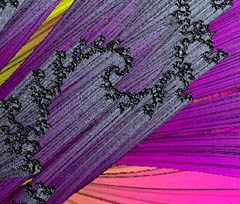Sandin & Kauffman Present at ArtSci2002
December 6th, 2002 - December 8th, 2002
Categories: Multimedia

‘A Volume of Julia Sets’
About
Daniel Sandin and Louis H. Kauffman are presenting their collaborative research, Explorations & Visualizations of Higher Dimensional Julia Sets, at ArtSci 2002. This collaboration started in the early 80’s with renderings of two-dimensional Julia sets on pre-IBM PC computers such as the TRS 80 laptop and the Datamax UV1 (Z-BOX).
Julia sets and other fractals can exist in three and higher dimensions. The collaboration is an actualization of an interest in visualizing these three-dimensional fractals both to understand their behavior and produce interesting images and animation. Since fractals are infinitely crinkly they don’t have normals. Further, Julia sets are usually computed in two dimensions by iterating a function hundreds or thousands of times for each pixel. When this concept is extended to three dimensions the number of voxels (3-D pixels) becomes very large.
In 1989 John Hart, a master of science graduate student in the computer science department at UIC, hit upon the idea of using a distance estimation technique witch made computation more efficient and provided a basis for determining surface orientation of three and higher dimensional fractal objects. A proof existed for a two-dimensional distance estimation technique and the form of the equations could be extended to higher dimensions. A proof of the three-dimensional distance estimation formulas eluded us until Yumei Dang, a student of Lou Kauffman pursuing a joint Ph.D. in mathematics and computer science, proved the distance estimation formulas to be correct.
From this work two animations were produced; a one-minute 35mm stereo movie, “A Volume of Two-Dimensional Julia Sets” for Siggraph 1990 and a super high definition (2Kx2Kx60Hz) visualization of quaternion (4D) Julia sets for Nippon Telephone and Telegraph’s 50th birthday celebration. This collaboration proved useful to the collaborators in several important ways. This collaboration has produced a series of artworks, new computer graphics rendering techniques, and mathematical proofs. In addition it was an excellent test vehicle for evaluating advanced computational and network techniques.
Related Site:
www.evl.uic.edu/hypercomplex/